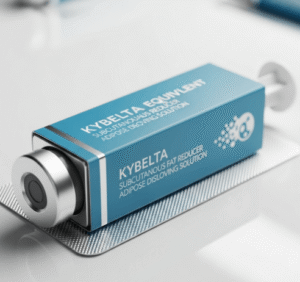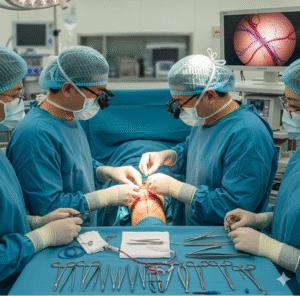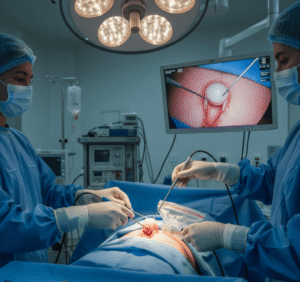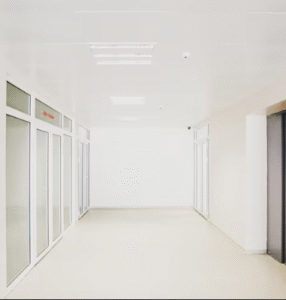Overview
Chiropractic care is a healthcare approach focused on diagnosing and treating musculoskeletal disorders, particularly those related to the spine, through manual adjustment and manipulation techniques. Chiropractors aim to improve physical function, reduce pain, and enhance overall health without the use of surgery or prescription medications.
Importance of chiropractic care:
- Helps manage back, neck, and joint pain.
- Improves spinal alignment and posture.
- Enhances mobility, flexibility, and nervous system function.
- Provides non-invasive, drug-free treatment options.
In South Korea, chiropractic care is offered in specialized clinics and wellness centers, often integrating modern diagnostic imaging and physiotherapy.
Why It’s Done
Chiropractic treatment is used to address musculoskeletal issues and associated symptoms, often as part of a broader wellness plan.
Common indications include:
- ➤ Lower back pain – chronic or acute.
- ➤ Neck pain and stiffness.
- ➤ Headaches and migraines linked to cervical spine issues.
- ➤ Joint pain in shoulders, hips, knees, or extremities.
- ➤ Postural problems due to prolonged sitting, computer use, or pregnancy.
- ➤ Sports injuries or repetitive strain injuries.
- ➤ Sciatica and nerve-related pain.
Benefits for patients:
- ✔️ Reduces pain and discomfort in the spine and joints.
- ✔️ Enhances range of motion and flexibility.
- ✔️ Promotes posture correction and ergonomic awareness.
- ✔️ Offers non-surgical pain management, often reducing the need for medications.
Alternatives
Alternatives to chiropractic care depend on the condition and may include:
- ➤ Physical therapy: Exercises and modalities to improve strength and mobility.
- ➤ Massage therapy: Relieves muscle tension and improves circulation.
- ➤ Medications: Pain relievers, anti-inflammatory drugs, or muscle relaxants.
- ➤ Acupuncture: For pain relief and musculoskeletal balance.
- ➤ Surgery: For severe spinal or joint conditions not responding to conservative therapy.
Key point: Chiropractic care is often part of a multimodal approach, combined with exercises, lifestyle changes, or other therapies for best results.
Preparation
Preparation for chiropractic treatment involves assessment and planning.
Steps include:
- ✅ Medical history review: Previous injuries, surgeries, chronic conditions, medications, and allergies.
- ✅ Symptom documentation: Pain location, intensity, triggers, and duration.
- ✅ Diagnostic imaging: X-rays, MRI, or CT scans may be requested to guide treatment.
- ✅ Clothing: Wear comfortable, loose-fitting clothes for ease of movement.
- ✅ Expectation setting: Discuss treatment goals, frequency, and potential outcomes with the chiropractor.
Important: Proper preparation ensures safe, effective, and targeted spinal or joint adjustments.
How It’s Done
Chiropractic treatment involves manual adjustments, mobilization techniques, and therapeutic exercises.
Step-by-step process:
- Initial assessment: Chiropractor evaluates posture, spinal alignment, joint function, and neurological signs.
- Palpation and range-of-motion testing: To identify restricted or misaligned joints.
- Manual adjustment or spinal manipulation:
- High-velocity, low-amplitude thrusts to restore joint motion.
- Gentle mobilization for sensitive areas or older patients.
- Soft tissue therapy: Massage, stretching, or instrument-assisted techniques.
- Exercise and rehabilitation guidance: Strengthening and flexibility routines for long-term improvement.
- Follow-up: Regular sessions based on the patient’s condition, response to treatment, and wellness goals.
Duration: 15–45 minutes per session, depending on the complexity.
Hospital stay: Outpatient; typically no hospitalization required.
Key point: Chiropractic adjustments are precise, individualized, and aimed at restoring function and relieving pain.
Recovery & Follow-Up
Recovery and improvement from chiropractic care depend on the condition and treatment frequency.
Immediate post-treatment effects:
- Mild soreness or stiffness in treated areas.
- Temporary increase in energy or sense of relief.
Short-term recovery:
- Regular adjustments may reduce pain, improve mobility, and correct posture over days to weeks.
- Exercise and lifestyle modifications enhance recovery and prevent recurrence.
Long-term outcomes:
- Sustained pain reduction and improved musculoskeletal health.
- Enhanced ergonomics, posture, and spinal function.
- Prevention of chronic issues and decreased reliance on medications.
Important: Adherence to the chiropractor’s guidance, exercises, and follow-up schedule is critical for optimal results.
Possible Complications
Chiropractic care is generally safe, but some risks exist:
- ⚠️ Mild soreness or stiffness after adjustments.
- ⚠️ Headache or fatigue in the first 24 hours.
- ⚠️ Temporary increase in pain in inflamed areas.
- ⚠️ Rare complications: Nerve injury, herniated disc exacerbation, or stroke (extremely rare with cervical manipulations).
In South Korea, licensed chiropractors follow strict safety protocols, diagnostic imaging, and patient assessment to minimize risks and ensure treatment safety.
Treatment Options / Clinical Relevance in Korea
Chiropractic care is widely available in South Korea, integrated into wellness, rehabilitation, and musculoskeletal clinics.
Key features:
- 🏥 Spinal and joint adjustments for pain relief and function restoration.
- 🏥 Therapeutic exercises and rehabilitation programs for long-term musculoskeletal health.
- 🏥 Integration with physiotherapy, massage, and acupuncture for multimodal treatment.
- 🏥 Preventive care programs for posture, ergonomics, and sports injury prevention.
- 🏥 Specialized clinics in urban areas providing advanced diagnostic imaging and chiropractic techniques.
Hospitals and clinics providing chiropractic care in Korea:
- Seoul Spine & Joint Center – Advanced chiropractic and physiotherapy care
- Asan Medical Center – Integrated musculoskeletal rehabilitation and chiropractic treatment
- Samsung Medical Center – Sports injury and spinal care clinics
- Private wellness and chiropractic centers nationwide – Accessible outpatient care
Highlights in Korea:
- ✔️ Non-invasive, drug-free treatment for musculoskeletal pain.
- ✔️ Integrated approach with rehabilitation, exercise, and preventive care.
- ✔️ Modern facilities with trained chiropractors and diagnostic imaging.
- ✔️ Enhances quality of life, posture, and physical function in children and adults.
Highlights
- ➤ Chiropractic care treats musculoskeletal disorders using manual adjustments and therapies.
- ➤ Indicated for back, neck, joint pain, headaches, postural problems, and sports injuries.
- ➤ Alternatives include physical therapy, massage, medications, acupuncture, or surgery.
- ➤ Preparation involves medical history, diagnostic imaging, and clothing for mobility.
- ➤ Treatment is outpatient, 15–45 minutes, and may include adjustments, soft tissue therapy, and exercises.
- ➤ Recovery includes immediate relief, short-term soreness, and long-term improved function.
- ➤ South Korea offers advanced chiropractic clinics integrated with rehabilitation, preventive care, and modern imaging.













